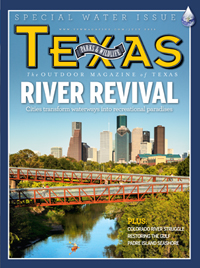
Water Session
Texas legislators tackled crucial water issues during the 83rd session.
Texas’ population is projected to nearly double by 2070. With this kind of population boom and a long-term drought, there’s concern about the future of water in Texas. Texas legislators addressed the topic by passing a number of bills in the 2013 session. In November, voters approved taking $2 billion from the Rainy Day Fund to use as seed money for water project loans.
Without such action, the state could be nearly 3 trillion gallons short of the water it needs by 2060 because of population growth and shrinking supplies, Rep. Allan Ritter said during the House debate.
Ritter’s House Bill 4 allocates $2 billion from the Rainy Day Fund toward a new State Water Implementation Fund for Texas. This water bank would offer loans for new water reservoirs, pipelines and conservation projects. Significantly, for the first time in Texas, the bill requires that 20 percent of funding go toward conservation and reuse, with another 10 percent toward rural water projects.
“Water is an essential part of everyone’s life, and ensuring adequate supplies means continued job creation, stronger communities and healthier families for decades to come,” Gov. Rick Perry said at the bill-signing ceremony. “HB 4 will help secure our water supplies for generations, even through rapid population and economic growth, by creating new funds that will support local and regional projects and lower the cost of issuing bonds for much-needed water projects.”
Legislators passed other water bills during the session as well. HB 857, by Rep. Eddie Lucio, requires water utilities to conduct annual water loss audits. HB 1461, from Rep. Jimmie Don Aycock, requires customer notification of audit results. Rep. Lon Burnam’s HB 3605 requires utilities to use a portion of state financial assistance funds to repair municipal water main leaks, which could save an estimated 20 billion gallons annually.
SB 198 from Sen. Kirk Watson makes it illegal for homeowners associations to prohibit members from utilizing xeriscaping and drought-resistant landscaping. An increase in drought-tolerant plants as opposed to traditional lawn grasses could save 14 billion gallons of water by 2020.
» Like this story? If you enjoy reading articles like this, subscribe to Texas Parks & Wildlife magazine.
Related stories
Now Is the Time to Address Water Needs
See more state park articles on our State Parks page

